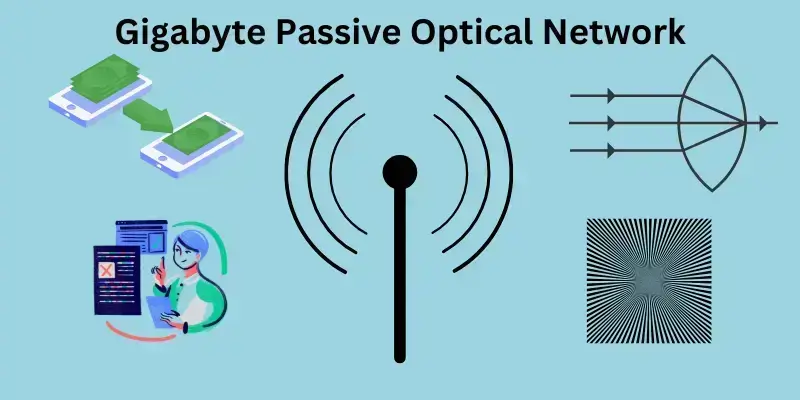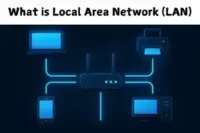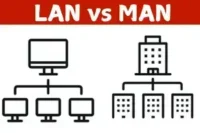Gigabyte Passive Optical Network: Unlock Faster Internet Now
Published: January 19, 2025
Have you ever wondered how modern internet connections can deliver high-speed performance without complex infrastructure? The answer lies in technologies like the Gigabyte Passive Optical Network (GPON), which provides fast and reliable broadband using optical fiber and passive components. But how exactly does it work, and why is it becoming so popular?

Explanation with real-life example
Imagine you’re trying to send a message to your friend across town. Instead of sending it by car, you send it through a super-fast, invisible road made of light! That’s how the Gigabyte Passive Optical Network (GPON) works—it sends information through light signals using fiber-optic cables. These cables can carry lots of data quickly, so your internet can be fast!
In a regular internet connection, you might have wires that send signals. But GPON uses light to send the signals, which is much faster. It’s like replacing a regular car with a super-fast sports car that zooms through the light beams!
Another cool part of GPON is the “passive” part. This means no active machines or power are needed in between; they are natural components. It makes everything more efficient and cheaper to maintain.
Why is it becoming so popular?
It helps bring high-speed internet to more people at once without needing expensive equipment. And since it’s faster and more reliable, it’s a favorite choice for businesses and homes, especially where fast internet is needed for gaming, video streaming, or working from home.
The “G” in the acronym stands for Gigabit, indicating that GPON connections can achieve speeds of up to 2.488 Gigabits per second downstream (from the provider to the user) and 1.244 Gigabits per second upstream (from the user to the provider).
How does GPON work?
Here’s a breakdown of GPON and its primary features:
Gigabit Passive Optical Network (GPON) uses fiber-optic technology to deliver high-speed internet, voice, and video services to end-users. Here’s a simple breakdown of how it works:
1. Central Office (OLT)
The Optical Line Terminal (OLT) is located at the service provider’s central office or data center.
It is responsible for sending and receiving data to and from the users.
The OLT manages bandwidth distribution, traffic, and the connection to the internet or other network resources.
2. Optical Distribution Network (ODN)
The ODN is the passive part of the network and connects the OLT to the user.
It consists of fiber-optic cables, passive splitters, and connectors. The ODN doesn’t require power to function.
Optical splitters divide the signal from the OLT into multiple paths, allowing it to be shared among several users over a single fiber.
3. Optical Network Unit (ONU) / Optical Network Terminal (ONT)
The Optical Network Unit (ONU) or Optical Network Terminal (ONT) is installed at the customer’s premises.
It converts the optical signals into electrical signals that devices like computers, phones, and TVs can use.
The ONU/ONT is responsible for receiving data from the OLT and sending data back upstream to the provider.
4. Passive Splitters
A passive optical splitter divides the incoming optical signal from the OLT into multiple optical signals. It allows a single fiber to serve multiple users.
Splitters come in various ratios, such as 1:2, 1:4, or 1:8, meaning one fiber can deliver service to two, four, or eight users.
5. Data Transmission
Data flows from the OLT to the ONU/ONT over the fiber-optic cables. This is the downstream direction.
When the user sends data (like browsing the web or streaming), it travels from the ONU/ONT back to the OLT. It is the upstream direction.
GPON uses Time Division Multiplexing (TDM) for downstream and Time Division Multiple Access (TDMA) for upstream to efficiently manage the data flow between multiple users and ensure fair access to bandwidth.
6. Bandwidth Allocation
GPON dynamically allocates bandwidth to each user based on demand. If a user is not actively using data, their bandwidth can be allocated to others.
Dynamic Bandwidth Allocation (DBA) ensures optimal use of network resources, providing higher efficiency and preventing congestion.
7. Quality of Service (QoS)
GPON supports Quality of Service (QoS), which prioritizes certain types of traffic, such as VoIP and IPTV, over general data traffic. It ensures that voice and video services maintain high quality, even when the network is under heavy load.
8. Security
GPON uses encryption to protect data transmitted between the OLT and the ONU/ONT, ensuring privacy and preventing unauthorized access.
Additionally, secure authentication ensures that only authorized users can access the network.
9. No Active Components in the Network (Passive)
The “passive” part of GPON refers to the Optical Distribution Network (ODN), which includes fiber-optic cables, splitters, and connectors. These components don’t require power, making the network cost-effective and low maintenance.
In summary, GPON uses an OLT to manage data and distribute it to multiple users via ONUs or ONTs through an optical distribution network. The system efficiently manages data traffic, allocates bandwidth, and provides high-speed services to residential and business users with minimal active components.
Advantages and Disadvantages of Gigabit Passive Optical Network (GPON)

Advantages of Gigabit Passive Optical Network (GPON)
Gigabit Passive Optical Network (GPON) offers numerous advantages for service providers and end-users. Its ability to deliver high-speed internet, cost-effective infrastructure, and scalable solutions make it a popular choice for broadband networks.
Benefits of GPON:
- High-speed data transmission (up to 2.5 Gbps downstream and 1.25 Gbps upstream)
- Efficient bandwidth management through Dynamic Bandwidth Allocation (DBA)
- Supports multiple services (internet, VoIP, IPTV)
- Cost-effective with minimal operational expenses
- Scalable infrastructure for growing user demands
- Low maintenance due to passive optical components
- Reduced power consumption (passive splitters)
- Supports long-distance transmission (up to 20 km)
- High-quality service with Quality of Service (QoS) management
- Secure data transmission with encryption
- Flexible network design (various topologies possible)
- High network reliability and minimal downtime
- Future-proof technology supporting high-capacity applications
- Easy integration with existing networks (especially Ethernet-based systems)
Disadvantages of Gigabit Passive Optical Network (GPON)
While Gigabit Passive Optical Networks (GPON) offer high-speed and reliable connectivity, they have certain limitations. Here are the potential drawbacks of GPON technology:
Drawbacks of of GPON:
- High initial installation and setup cost
- Limited distance range for effective transmission
- Bandwidth shared among multiple users
- Scalability challenges in densely populated areas
- Limited upstream bandwidth for data upload
- Complex and costly network upgrades are required
- Signal degradation over long fiber distances
- Vulnerability to damage from external factors
- Specialized equipment required for installation
Difference between GPON and EPON
Here is the difference between a Gigabit Passive Optical Network (GPON) and an Ethernet Passive Optical Network:
| Feature | Gigabit Passive Optical Network | Ethernet Passive Optical Network |
| Technology | Uses ATM (Asynchronous Transfer Mode), GEM (GPON Encapsulation Method), and TDM (Time Division Multiplexing). | Based on Ethernet technology. |
| Speed | Offers up to 2.5 Gbps (downstream) and 1.25 Gbps (upstream). | Typically offers symmetrical speeds of 1 Gbps. |
| Efficiency | More efficient due to the GPON Encapsulation Method (GEM). | Less efficient because it uses Ethernet frames. |
| Cost | Higher deployment costs due to complex protocols and licensing. | Lower costs because Ethernet is widely used and simpler. |
| Scalability | Better scalability and performance for large networks. | Suitable for smaller networks with moderate demands. |
| Standards | ITU-T G.984 standard. | IEEE 802.3 standard. |
| Application | Commonly used for telecom operators and large-scale broadband services. | Frequently used in small businesses and residential areas. |
| Bandwidth Allocation | Uses dynamic bandwidth allocation, which is more efficient for varying demands. | Uses static bandwidth allocation, which may be less flexible. |
| Latency | Lower latency due to its TDM-based mechanism. | Slightly higher latency due to Ethernet’s nature. |
| Power Consumption | Slightly higher power requirements at endpoints. | Lower power consumption at endpoints. |
Wrapping Up
In this article, we’ve explored the key features of Gigabit Passive Optical Network (GPON). Considering its high-speed performance, cost-efficiency, and minimal maintenance, I recommend GPON for businesses and homes requiring fast and reliable internet, especially for gaming, streaming, and remote work applications. While it’s a great solution, consider challenges like bandwidth sharing and scalability in densely populated areas. If you plan to upgrade your network, GPON is a future-proof choice that can meet your high-capacity needs. You should learn more about its benefits and contact a network expert to see how GPON can enhance your infrastructure.
FAQs about Gigabyte Passive Optical Network
GPON is a high-speed fibre-optic technology that delivers internet, TV, and phone services to homes and businesses. It uses light signals to transmit faster and more reliable data than traditional copper cables.
GPON splits a single fibre-optic line into multiple connections using passive splitters. It allows one central connection to serve multiple users without needing active electrical equipment at every split.
GPON typically offers download speeds of up to 2.5 Gbps and upload speeds of up to 1.25 Gbps. These speeds are much faster than traditional broadband connections.
A GPON system consists of an Optical Line Terminal (OLT) at the service provider’s end, passive splitters to divide the signal, and Optical Network Units (ONUs) or Optical Network Terminals (ONTs) at the user’s location.
Unlike traditional point-to-point fibre, GPON uses passive splitters to share a single fibre line among users. It reduces costs while maintaining high-speed internet access.
Yes, GPON is secure because it uses encryption to protect data. Each user’s data is separated to ensure privacy and prevent unauthorized access.
GPON offers faster speeds, higher bandwidth, and more reliable connections. It is energy-efficient, cost-effective for service providers, and supports multiple services like internet, TV, and phone services on a single line.
GPON networks typically range up to 20 kilometres (12 miles) from the central office to the user. It makes it suitable for urban and rural areas.
GPON is ideal for businesses due to its high speed, reliability, and ability to support multiple devices and services. It is commonly used in offices, hotels, and large organizations.
GPON (Gigabyte Passive Optical Network) and EPON (Ethernet Passive Optical Network) are similar but use different protocols. GPON offers higher speeds and better efficiency, while EPON is simpler and often used for smaller networks.
A Gigabit Passive Optical Network (GPON) uses the five layers of the TCP/IP model to handle data transmission, routing, reliability, and user communication over fibre-optic connections.





